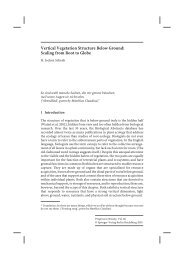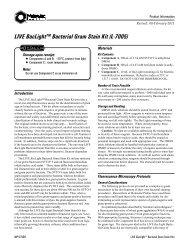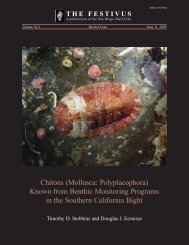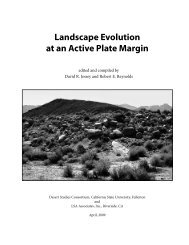2010 Overboard in the Mojave - Biological Science - California State ...
2010 Overboard in the Mojave - Biological Science - California State ...
2010 Overboard in the Mojave - Biological Science - California State ...
You also want an ePaper? Increase the reach of your titles
YUMPU automatically turns print PDFs into web optimized ePapers that Google loves.
27.1 (0.5) TURN RIGHT (north)<br />
at <strong>the</strong> pole with reflectors (Post # 2<br />
2404—Oak Grove Road).<br />
27.2 (0.1) PARK at utility road.<br />
STOP P-2—Johnston Corners<br />
Pliocene GWD. The sedimentary<br />
section at this locality starts at<br />
<strong>the</strong> railroad tracks to <strong>the</strong> north. It<br />
beg<strong>in</strong>s with coarse gravels that are<br />
angularly overla<strong>in</strong> by a section of<br />
f<strong>in</strong>e-gra<strong>in</strong>ed sand, very f<strong>in</strong>e gravelly<br />
sand, and calcareous sand and silt.<br />
Some calcareous beds are strongly<br />
cemented, similar to <strong>the</strong> upper<br />
carbonate cemented caps of late<br />
Pleistocene GWD (e.g., Forester<br />
et al, 2003). The section cont<strong>in</strong>ues<br />
south of <strong>the</strong> road and is capped<br />
on <strong>the</strong> skyl<strong>in</strong>e by a pediment<br />
marked by a veneer of boulders. A<br />
carbonate-cemented bed nearby<br />
conta<strong>in</strong>s silica, which yielded an<br />
approximate U-Pb age of 2.3 Ma<br />
(K. Maher, written commun. to Miller, 2005). This date<br />
suggests a correlation with <strong>the</strong> beds we saw at Stop P-1<br />
<strong>in</strong> Barstow. Return to vehicles, Retrace south to National<br />
Trails Highway.<br />
27.7 (0.4) Stop at National Trails Highway. TURN<br />
RIGHT and proceed west.<br />
28.7 (1.0) Cont<strong>in</strong>ue past H<strong>in</strong>kley Road and Hodge.<br />
33.6 (5.6) Cont<strong>in</strong>ue past Holcomb Ranch Road.<br />
34.5 (0.9) TURN RIGHT (north) on Indian Trails Road.<br />
Proceed toward railroad.<br />
35.2 (0.7) TURN LEFT (west) on <strong>the</strong> south railroad<br />
frontage road.<br />
36.3 (1.1) Pass through a dip and proceed 0.2 miles to an<br />
outcrop on <strong>the</strong> left (south).<br />
36.5 (0.2) STOP P-3—Helendale Ash (Reynolds and<br />
Cox, 1999). Helendale Ash sampled here is a Mono “W”<br />
type tephra, <strong>in</strong>dicat<strong>in</strong>g an age range from 5.0 to 0.7 Ma.<br />
It best correlates with a sample from <strong>the</strong> Ventura section<br />
that is between 0.9 and 1.18 Ma. The Helendale Ash is<br />
located at <strong>the</strong> base of <strong>the</strong> <strong>Mojave</strong> River gravels (2500 ft<br />
elev.), and overlies <strong>the</strong> f<strong>in</strong>e sediments of <strong>the</strong> Victorville<br />
Bas<strong>in</strong>. This sequence suggests that <strong>the</strong> river had f<strong>in</strong>ished<br />
fill<strong>in</strong>g <strong>the</strong> Victorville Bas<strong>in</strong> by ~1 Ma, and <strong>the</strong>n began<br />
carry<strong>in</strong>g coarse sands far<strong>the</strong>r east. The elevation of this<br />
~1 Ma ash helps constra<strong>in</strong> <strong>the</strong> section that we will see at<br />
r. e. reynolds and d. m. mller<br />
Stops P-4 and P-5. RETRACE east along <strong>the</strong> south side of<br />
<strong>the</strong> railroad for 0.2 miles.<br />
36.7 (0.2) TURN RIGHT (south) through a break <strong>in</strong> <strong>the</strong><br />
fence and follow OHV tracks <strong>in</strong> wash to reach terrace top.<br />
37.2 (0.5) Complex <strong>in</strong>tersection. TURN NORTH, <strong>the</strong>n<br />
bear west along bluff road. Do not turn south toward<br />
houses or pole l<strong>in</strong>e road.<br />
37.5 (0.3) Proceed west, pass<strong>in</strong>g a left (south) turn. Note<br />
lag gravels on <strong>the</strong> terrace top.<br />
37.9 (0.4) Bluff Road drops off terrace top (elevation<br />
2600 ft) <strong>in</strong>to broad canyon.<br />
38.1 (0.2) Stop P-4—Helendale Section (2480 ft elevation)<br />
<strong>in</strong> wash bottom. Note red paleosols, and green pond<br />
sediments that probably represent f<strong>in</strong>e sediments of <strong>the</strong><br />
early Pleistocene Victorville bas<strong>in</strong>. We will see <strong>Mojave</strong><br />
River sands at higher elevations as we follow <strong>the</strong> road<br />
uphill to <strong>the</strong> southwest. The GWD capp<strong>in</strong>g <strong>the</strong> bluffs may<br />
correlate with those at Johnston Corners and far<strong>the</strong>r east<br />
at Lenwood, suggest<strong>in</strong>g a broad, marshy, east–west valley<br />
bottom dur<strong>in</strong>g <strong>the</strong> late Pliocene and earliest Pleistocene.<br />
38.3 (0.2) Jo<strong>in</strong> a road that proceeds south to <strong>the</strong> pole l<strong>in</strong>e<br />
road. PARK on hill crest where space is available.<br />
38.6 (0.3) Stop P-5—Helendale GWD at 2600 ft on<br />
ridge top supported by GWD carbonates. This unit is<br />
similar to those above Stop P-4. About 10 km to <strong>the</strong> westnorthwest,<br />
Dibblee mapped similar white beds as lake<br />
20 <strong>2010</strong> Desert Symposium
















